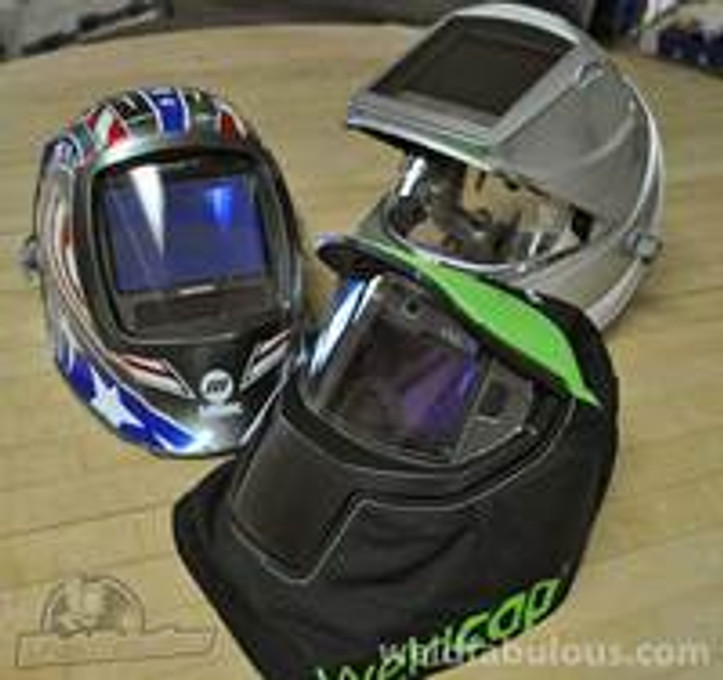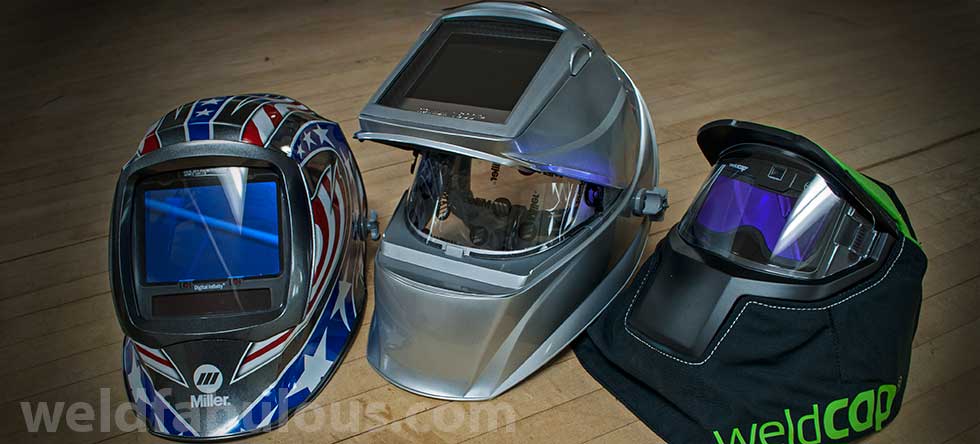
How to Pick the Proper Welding Helmet
Posted by Ben on Jan 29th 2016

Today’s welder has many options when it comes to selecting the right welding helmet. Some want style, some want value, but everyone wants protection. We only have two eyes after all, right? In this post I will go over some of the main points of choosing a helmet along with some not-so-main points that can make the decision easier. Weldfabulous offers helmets from a variety of manufacturers so I will concentrate on what they have available. Not to say that others are bad, but I will focus on what I am familiar with.
The type of welding helmet is the first thing to consider when looking for a helmet. To keep it simple, I will discuss two types: fixed shade and auto darkening.
A helmet with a fixed shade passive lens is a mainstay in many welding arenas made of high temperature glass that does not change its shade. This type of helmet contains no fancy buttons to push for setup and no light shade to work with your helmet down while not welding. Most out-of-the-box fixed shade helmets come as a shade 10. For all fixed shade helmets we offer, you can purchase filter plates from shades 7 to 14 and interchange them as needed. Also included in the fixed shade helmets are inside and outside clear protective lenses. These lenses protect the filter shade from slag and scratches, and provide an extra level of protection from flying debris while welding (not a common occurrence, I hope). We have a small selection of fixedshade helmets available online from Miller, Tillman, and Revco.
The other type of welding helmet, auto darkening, is not so clean cut. Auto darkening helmets offer a variety options: welding process, viewing size, shade choice, control format, clarity, style, and comfort. This can easily become overwhelming if you are purchasing your first helmet, or finally replacing that old standby that you have had hanging in the shop for years. At this point, one easy way to narrow down your search is price. How much are you able or willing to budget for this helmet? I know some always go for the A-list helmet for different reasons, but there are some very good helmets available that fall into the budget-friendly category as well. I will touch more on that in a bit.
Firstly, you should consider what process(es) you will be performing to be sure the helmet you purchase is able to provide the necessary protection. Are you MIG welding? All of the helmets we offer will work well for MIG welding applications. Are you stick welding, or a combination of MIG/stick? All will work for these as well. If you are TIG welding, how low is the amperage you are running? Some auto darkening helmets will only go down to 20 amps. This means that if you are doing any low amperage TIG application, between 1 and 20 amps, the lens is not sensitive enough to darken. While this is not the most common range, it does apply to welders doing micro TIG and specially welding. If you are doing either of these, your helmet budget will increase because most budget-friendly helmets do not fall in this field. Again, although it is rare, I bring up the point on the TIG welding amps because it has happened, and nobody wants to suffer an arc flash. Even if it’s low amperage, it can damage your eyes all the same.
Secondly, viewing size should factor into your decision. Auto darkening lenses come in a variety of sizes, the smallest being the new Weld-Maskby Miller Electric and Weldcap by Optrel. These are a bit like welding with glasses on. Well, kind of. They both also provide a face shield and head cover to protect you from getting a shop tan in the middle of winter. Also available are the 2” x 4” lenses that provide you with a viewing area of 3.7” x 1.4”, and can easily be put into any welding helmet with that size opening. Honestly, I would get a little off track if I described all the sizes available at Weldfabulous. There are many sizes larger than the 5.18 sq. in. in the 2” x 4” lenses. Miller Electric currently offers what I believe to be the largest auto darkening lens in its Digital Infinity Series, having 13.4 sq. in. of visibility while welding. In most cases, the larger the lens, the more your piggy bank may get broken. You might want to hide the mallet so the piggy doesn’t run away.
Thirdly, you should examine your needs in shade choice and control. I consider these two separate options, but they are very closely related so I will combine them in an attempt to avoid getting too wordy. If you are looking for a lens or helmet that is a single shade but is also auto darkening, the FS#10 series helmet by Miller Electric is a great option. The FS #10 series helmet comes from factory with a shade 10 lens, and has a variety of additional lenses that provide a fixed shade, ranging 8-11, that go to a light stage 3 when not above an arc. This lens is small but efficient and the lenses will work in any helmet offering a 2” x 4” opening. No buttons, not frills, just protection. (This helmet and/or lenses would not be recommended for TIG welding.) If you are looking for variable shade options, there are several options -- from 8-12 shade with analog dials for shade adjustability and sensitivity, to welding and grinding shades built with a digital screen to see all your settings at a glance. We offer a great selection from industry leaders like Miller Electric, Speedglas, Optrel, Lincoln Electric, and Weldcote Metals. Most have controls inside the helmet right below the viewing window. Others have controls and adjustments outside the helmet like the Optrel line of high-end helmets. This may be something to keep in mind if you are looking for one or the other in your new helmet.
Lens clarity has become a big part of the welding helmet buzz over the last year. There are now standards provided to us by the European Standard EN 379 1/1/1/1 that set benchmarks for helmet lens manufacturers. This standard gives guidance on the following components: optical class, diffusion of light, variations in luminous transmittance, and angle dependence on luminous transmittance. This development will continue to make lenses better for everyone that uses them. Please take a look at the article by Jamy Bulan provided by The Fabricator for more detail.
Lastly, or for some of you this may be closer to the top of the list, I’ll discuss style and comfort. Welders have an inherent desire to look cool and to express themselves as who they are. And for a welder, the helmet they wear can say a lot about who they are. Styles can show where you came from, what you have done, refer to those who have been part of your life, and can also be plain and unassuming. Everyone wears a different hat and there are many designs and styles out there to fit who you are. We offer great designs from Miller Electric, Speedglass, and Lincoln Electric, as well as many with a blank slate for you to show who you are in your own way. Also, to keep you comfortable, many helmets now come with much more form fitting headgear to better distribute the weight of your helmet to create less of a strain on your neck and shoulders. The essential point is that all the welding helmets we offer provide safety and security, protecting the welder’s eyes while they’re doing what they love.
Purchasing the correct helmet for your job or application is the key to providing yourself with protection each and every day you use it. Ask yourself what you need, set a budget, think about the options and types available, and purchase what is right for you.
